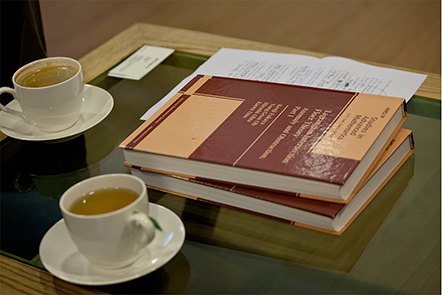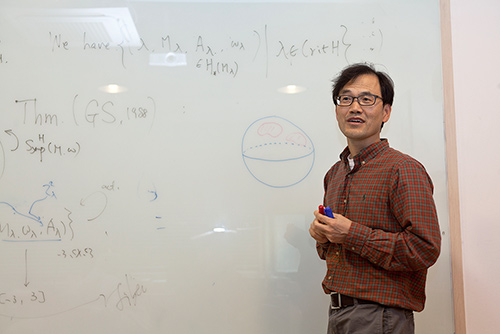주메뉴
- About IBS 연구원소개
-
Research Centers
연구단소개
- Research Outcomes
- Mathematics
- Physics
- Center for Theoretical Physics of the Universe(Particle Theory and Cosmology Group)
- Center for Theoretical Physics of the Universe(Cosmology, Gravity and Astroparticle Physics Group)
- Center for Exotic Nuclear Studies
- Center for Artificial Low Dimensional Electronic Systems
- Center for Underground Physics
- Center for Axion and Precision Physics Research
- Center for Theoretical Physics of Complex Systems
- Center for Quantum Nanoscience
- Center for Van der Waals Quantum Solids
- Chemistry
- Life Sciences
- Earth Science
- Interdisciplinary
- Institutes
- Korea Virus Research Institute
- News Center 뉴스 센터
- Career 인재초빙
- Living in Korea IBS School-UST
- IBS School 윤리경영


주메뉴
- About IBS
-
Research Centers
- Research Outcomes
- Mathematics
- Physics
- Center for Theoretical Physics of the Universe(Particle Theory and Cosmology Group)
- Center for Theoretical Physics of the Universe(Cosmology, Gravity and Astroparticle Physics Group)
- Center for Exotic Nuclear Studies
- Center for Artificial Low Dimensional Electronic Systems
- Center for Underground Physics
- Center for Axion and Precision Physics Research
- Center for Theoretical Physics of Complex Systems
- Center for Quantum Nanoscience
- Center for Van der Waals Quantum Solids
- Chemistry
- Life Sciences
- Earth Science
- Interdisciplinary
- Institutes
- Korea Virus Research Institute
- News Center
- Career
- Living in Korea
- IBS School
News Center
| Title | A 'Textbook' is Published on Symplectic Topology and Floer Homology | ||||
|---|---|---|---|---|---|
| Name | Department of Communications | Registration Date | 2015-11-13 | Hits | 3164 |
| att. |
 thumbp1.jpg
thumbp1.jpg
|
||||
|
A ‘Textbook’ is Published on Symplectic Topology and Floer Homology - By Dr. OH Young Geun, Director at IBS and Professor at POSTECH -
The office was a comfortable, welcoming place unlike other typical science labs. The office belongs to Director OH Young Geun of the IBS Research Center for Geometry and Physics and professor in the Department of Mathematics at POSTECH in Korea. His book, Symplectic Topology and Floer Homology was published by Cambridge University Press last September. This two-volume set has been receiving positive reviews stating that it is a useful textbook for scholars or students who have just begun studying Floer homology. Finally Solved Difficulties Encountered in Graduate SchoolDirector OH first became interested in geometry as a college student at Seoul National University, and then began studying symplectic geometry while doing a master’s and Ph. D in U.C. Berkeley. In 1985, when he was at Berkeley, a mathematician named Mikhail Gromov published a monumental paper on symplectic geometry which revolutionized the field in the two decades that followed. However, it still wasn’t easy for OH to study symplectic geometry as a student.
“I encountered many difficulties in graduate school studying symplectic geometry. There weren’t any sources that provided well-structured information, so I had to teach myself just by reading papers. I began researching the field 20 years ago, but I still see newcomers struggling,” said Director OH. This experience in graduate school motivated him to write and publish an introductory book on symplectic geometry for beginners. “The book is the product of my ten-year effort,” said Director Oh, “I planned this book targeting graduate students and new post-doctoral researchers.” He drafted it based on his lectures from 2002 to 2005 at the University of Wisconsin where he spent twenty years of his research career and put the final touch on it after joining IBS two years ago. He said, “I co-authored a book on symplectic geometry with several Japanese mathematicians in 2009. But the book was not easy for graduate students or post-doctoral researchers because it covered general theories only and didn’t present specific examples to assist their understanding.” “This book,” he emphasized, “is a work of my own and comprehensively covers problems and their solutions in symplectic topology.” In particular, this newly published book uses Floer homology as a tool to solve symplectic topological problems. The book, he explained, offers comprehensive guidance on areas such as analysis, geometry and algebra because broad mathematical knowledge on them is necessary to properly utilize Floer homology. Floer Homology = Quantum Homology?While geometry investigates shapes, size and the properties of space, topology is concerned with specific properties of space that are preserved under continuous deformations. Take a doughnut, for example. While geometry studies the curvature of the doughnut, topology focuses on the hole in its center because the hole never goes away with deformations such as stretching and bending. Understanding symplectic geometry and topology should begin with Hamiltonian formulation of classical mechanics. Director OH explains that basic components of Hamiltonian mechanics can be conceptualized to achieve symplectic manifolds, of which properties symplectic geometry or topology studies. For example, basic components such as location-velocity and the size of area can be preserved to achieve symplectic manifolds through conceptualization. “Mathematicians adopt every tool available to identify the geometrical properties of structures. To understand extremely puzzling and subtle properties of symplectic manifolds, a very complicated and sophisticated analytical tool becomes necessary. The very mathematician who invented that tool is Mikhail Gromov,” explained Director OH. As astronomers sent a spaceship to collect data on the properties of space, mathematicians set up a class of special sub-manifolds called Lagrangian submanifolds, in symplectic manifolds and move them to look into their dynamical interactions. By looking into interactions between Lagrangian sub-manifolds, they can infer the properties of the space outside of them. The algebraic methodology they adopt during the process is Floer homology in symplectic topology. Floer homology was theorized by a German mathematician Andreas Floer in the late 1980s when he worked as a post-doctoral researcher at the State University of New York. Combining the Gromov theory and Hamiltonian mechanics, he developed the idea of Floer homology to resolve the Arnold conjecture. The Arnold conjecture, proposed by a Russian mathematician Vladimir Arnold, assumes that the number of periodic points - a point, for example, where a paper boat floating on a lake comes back in one hour- in Hamiltonian currents in symplectic manifolds must be at least the same as homological complexity in symplectic manifolds.
What are the differences between classical homology and Floer homology? Classical homology reveals important topological information and presents basic methods to mathematically differentiate planes, curved surfaces and tori. For example, a random circle on a curved surface can be reduced in size to become a point but a circle that rotates the center hole in a torus cannot become a point. This center hole is an element of homology. In contrast, according to Director OH, Floer homology is an invariant defined by periodic trajectories and cylindrical complex curved surfaces that connect these trajectories. The energy level of homology is zero in classical homology, which is expanded to all energy level in Floer homology. In this respect, Floer homology can be called quantum homology. Symplectic Geometry and Complex Geometry Constitute Mirror Symmetry“Even though Floer developed Floer homology to resolve Arnold conjecture, the idea has now become a fundamental tool to study symplectic topology,” said Director OH, “I have been researching to apply it to other problems concerned with symplectic topology based on belief in Floer homology. In the mid-1990s when he was at the Isaac Newton Institute for Mathematical Sciences at the University of Cambridge as a visiting researcher, Director OH used Floer homology to solve symplectic topological problems other than Arnold’s conjecture for the first time. Also, he successfully inferred Floer spectral invariant, a concrete invariant, through abstractly defined Floer homology. He was invited to the 2006 International Congress of Mathematics in Madrid, Spain and gave a lecture about applications of Floer homology to many symplectic topological problems and how he adopted new methodologies. Japanese mathematicians coined the word ‘symplectic’ using an ancient Greek word, sym-plektos, which means ‘complex’. Though there was an attempt to name the field as ‘complex geometry’ in the early 20th century, the geometry based on complex numbers has already been named as ‘complex geometry’. According to Homological Mirror Symmetry proposed by Russian mathematician Maxim Kontsevich, a Fields Medal winner, complex geometry and symplectic topology constitute interesting mirror symmetry though they look completely different on the surface. This means a problem that seems extremely difficult from one perspective can be much easier from the other perspective and thereby is more likely to be solved. In theoretical physics, symplectic geometry and string theory greatly influence each other producing significant outcomes. For example, after Gromov found that the probes he used to study symplectic manifolds are in fact identical to the objects of nonlinear sigma model studied by the string theorist Edward Witten, Gromov-Witten theory was born in the early 1990s. “Symplectic geometry and complex geometry can refer to each other because they form mirror symmetry,” said Director OH, “we set our research direction and themes based on this mirror symmetry.” For example, a problem in one field can be approached from a different perspective adopted from the other field and solved much easily. Director OH has long dedicated himself to easing applications of Floer homology. Writing a book on symplectic topology incorporating Floer homology as a tool must have been the natural next step for him.
|
|||||
| Next | |
|---|---|
| before |
- Content Manager
- Public Relations Team : Suh, William Insang 042-878-8137
- Last Update 2023-11-28 14:20














